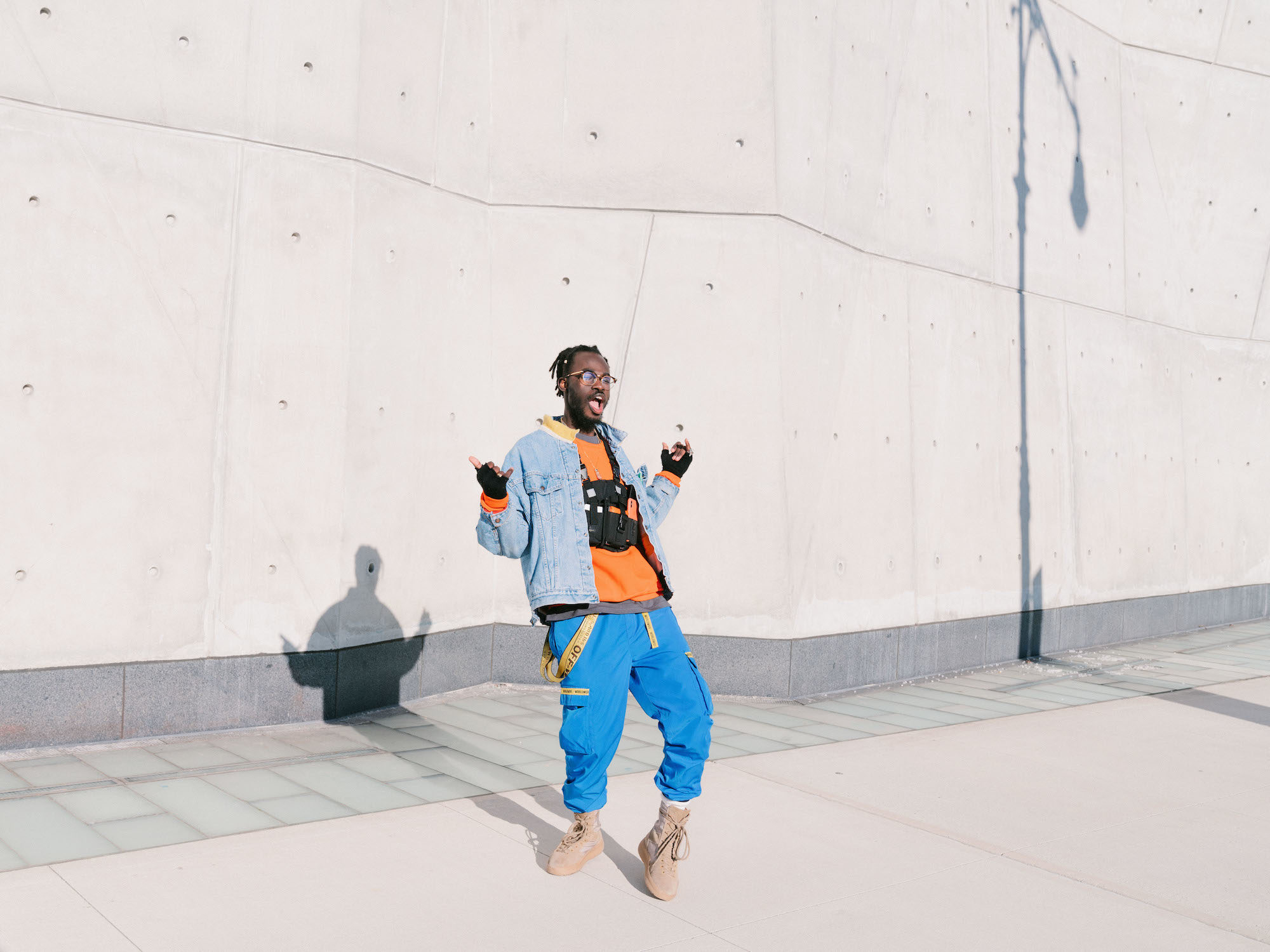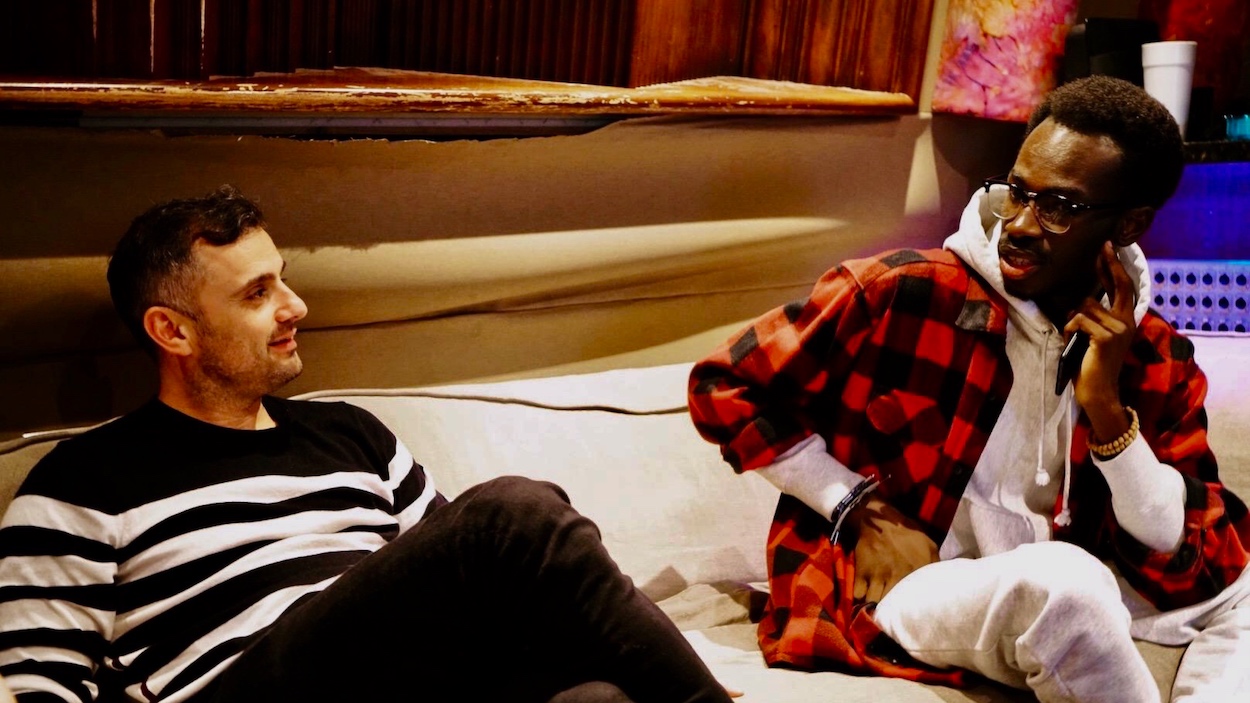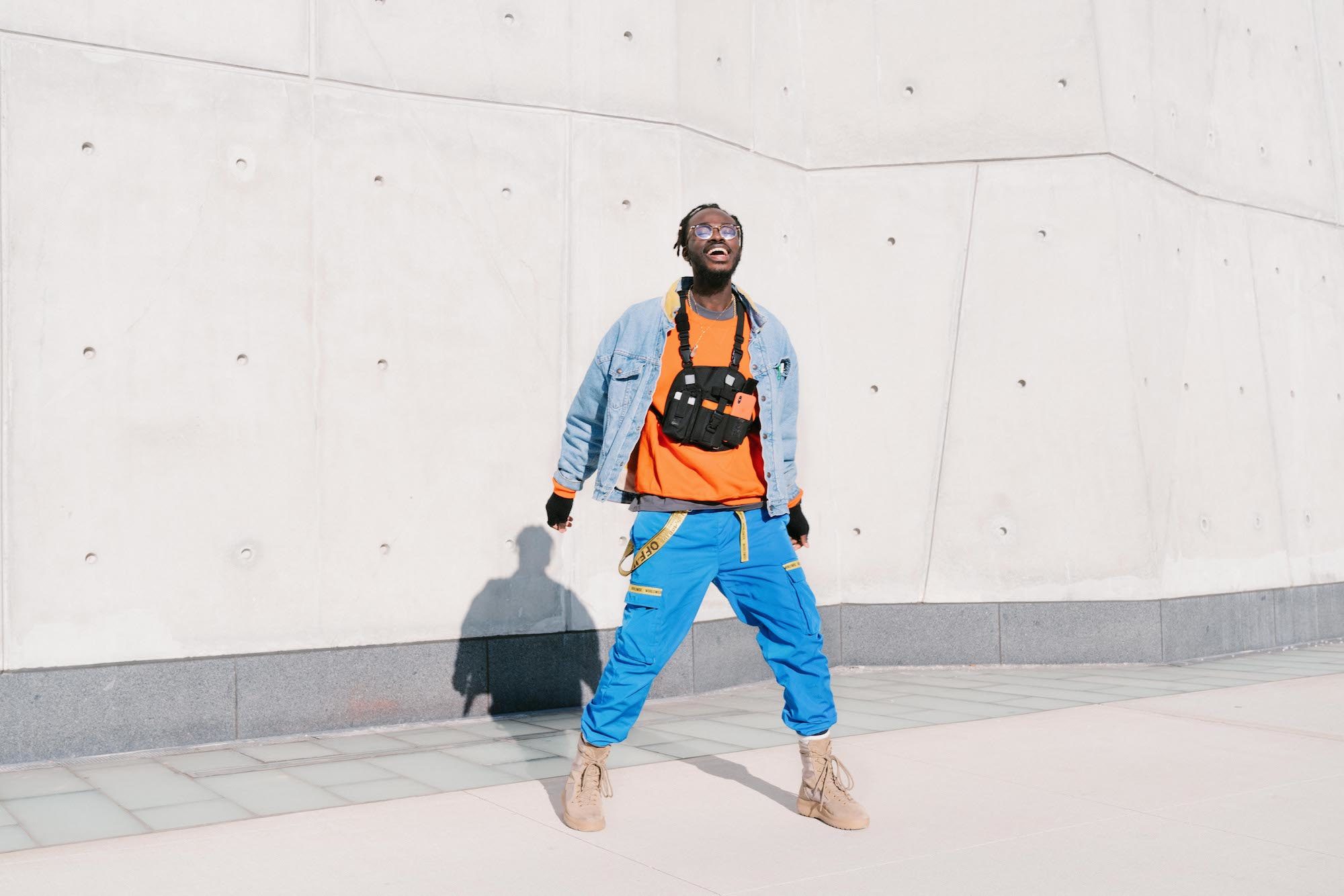Can tech be hip hop? Iddris Sandu is living proof that it can. The Ghana-born, Compton-bred 21-year-old is a bit of an anomaly. He was coding for Google at 13. Everyone from Snapchat to Instagram to Uber has enlisted his services to write algorithms. He received a commendation certificate from President Obama. Conceived the world’s first smart retail experience, The Marathon Store, with the late rapper Nipsey Hussle. Designed an album cover for Kanye West. Gave a Ted Talk. Conceived a high-tech parking meter that will be unveiled this year in L.A. Founded a self-styled clothing label, Unbranded, set to launch at ComplexCon in July. The aesthetic will hew closely to his personal uniform, which is something of a cross between streetwear and construction-worker garb. His mission now is to bridge the divide between the tech industry and minority communities, and to bring good design to everyday objects that don’t have the sex appeal of aspirational gadgets and products. The multi-hyphenate Sandu defies the laws of the tech mogul typecast. So how to define him? “An architect,” he says. “I’m learning about design in different cultures and how we can apply that to societal structure, app development, product design, industrial engineering, health care, and so many different things. Being able to bring together technology and culture in a way that is seamless, to where it’s not even like I’m a tech guy. I’m simply architecting.”
Iddris Sandu is Going to Change the World
The 21-year-old has coded for tech's biggest names, collaborated with hip-hop stars, and received honors from the president. Now he has even bigger plans.
By Nate StoreyPHOTOS BY Emanuel Hahn
April 01, 2019
You’ve compared platforms such as Google Android and Apple IOS to the Constitution and apps to laws when discussing the inherent lack of diversity on those operating systems. Explain that analogy.
Technology is never biased. Technology is not the enemy. It’s the people who write the algorithms—it’s the people behind the technology that can choose to infer bias on it or not. Think of an operating system as the digital version of a Constitution that governs your phone You can create any app as long as it either coincides with the Constitution or the people that created the Constitution. Think about the founding fathers. A lot of them had slaves right? So, the Constitution says we have liberty and justice for all, pursuit of happiness, things like that. But we all know—and it’s blatantly raw—that the Constitution specifically helps one demographic more than others. Understanding that, the first version of Google Android wasn’t initially developed with diversity in mind. It was created to cater to a specific demographic group. Steve Wozniak and Steve Jobs created the Apple II for the middle class American white family. Those were the only people who were able to afford and utilize it. It wasn’t a product for a necessity—it was for aspiration.
What is the negative outcome of that kind of system?
Our kids are being taught to build on these platforms that are super biased. We’re failing them as educators if we put them in the very system that oppresses them. Think of the top hundred apps in the app store. Think about Facebook creating React. Think about Apple creating Swift. All these [are] program languages to get the youth into the habit of renting and not owning. When you create an app, you’re renting space in the app store, and it can be immediately removed [at any time].
Think of the sneaker industry. It took people like the founders of StockX and Goat—the latter being started by a minority—to be able to say, hey, this is a billion-dollar industry that nobody is tapping into. But even when they wanted to submit their app into the store, they had problems with Apple. They wanted to submit an amendment. Oh, denied. At the end of day, Apple is the supreme law of the land as it applies to iOS and Larry Page and others are in charge of that structure with Google.
The shelf life of any advertisement is about thirty seconds now, right? The fact that you go on a platform [like] Instagram, and you look at something and literally have about ten seconds to sell me on whether I should continue watching the video, or sixty seconds [for me to] engage with you or buy that product. We’ve been conditioned with that.
All of this comes down to psychology. All these tech companies—they’re scientists. There are people who analyze data, understand user engagement and user behavior and they sort of purge on this.
You know that long text that pops up when you first download an app that we all scroll through and click agree to?
Well that’s a form of a contract.
A form of contract known as a contraction of adhesion. Also known as a “take it or leave it contract Either you fuck with it and you’re okay with this, or you can’t use our app, and then [we’ll] keep launching the app until you click “yes.”
How can design help to solve these issues?
I like to tell people that, first and foremost, I’m an architect. I’m immersed to [many] cultures. I’ve been studying biomimicry for the last two years and giving lectures at Stanford on how to apply it to user experience design. The beautiful thing about biomimicry is we’ll never be able to fully replicate nature. You’ll never fully be able to replicate organic matter. But you can do your best to replicate, assimilate, interpret, or simulate it. You know who the best creative director is? Nature.We can study nature and how it creates efficient systems all across the board, on a low level and a high level. Free information, very cost-effective. Water wears down mountains.
A singular stream of water being met with a force that causes a lot of pressure can break a stone in half.

Why are so many important things in the world so poorly designed?
I have this law of two percent: The law of two percent is basically to let everyone focus on the ninety-eight percent of the world’s problems and we’ll focus on the two percent of the world’s problems. Now, [those] two percent of the world’s problems are those things that no one else wants to focus on. The real trillion-dollar ideas and solutions. So on a global scale those are the two percent.
Everyone wants to focus on aspirational products. There are hundreds of different machining methods and processes that go into making that beautiful piece of glass in the iPhone. I think of the varied infrastructure that’s necessary within our society, like parking meters.
This is aspirational necessitation. We should apply the same amount of detail, attention, and beautification that’s applied to an iPhone to infrastructure that’s needed in our everyday society. Everything from street lights to the buttons that you press when you cross a sidewalk to things that are needed for basic living, like beds, rather than aspirational products.
One of your goals is to bridge the gap between Silicon Valley and minority communities. How do you plan to do that?
It starts with the education and how you introduce it. The knowledge within the black community hasn’t been something that’s been pushed for, in terms of [applied sciences] and coding. It’s something that hasn’t been “sexy” within these demographics. “What? Programming? Get out of here!” You know what I mean? Nerd and all of that. It’s about who co-signs it and introduces it to the market.
I think about what I did with Nipsey Hussle—creating that smart store in L.A. (Editor’s note: This interview took place before Nipsey Hussle was tragically gunned down outside the Marathon Store yesterday.) Nipsey saw me breaking down the barriers in tech and said, “Hey, you know what? Let me deliver you right to the gate of hip hop, because your audience can now reach a gazillion times more energy if you’re co-signing that space.”
Beyoncé just featured me on her website for Black History Month. The spotlight [is] on this dude who’s shaping the culture, but understands that tech is cool, which is always subjective. Make it look cool and sexy. And now, being a software engineer is on the same level as being a rapper or being a celebrity. It’s also a paradigm shift. I understand technology on the level of a Steve Jobs [or] Steve Wozniak. I understand more than ten programming languages, including Java, C+, Python, Node.js, HTML, Fortran—but I also understand culture and hip hop. Understand Grandmaster Flash, DJ Kool Herc, Afrika Bambaataa and Tupac. Understand what Public Enemy and A Tribe Called Quest meant for hip hop. Understand Machiavelli. Understand Nas’s Illmatic, Jay-Z’s The Black Album, The Blueprint, Blueprint 2, 3, and 4, and Kanye and everything that he’s done. I understand the end-to-end moment, the handshake that we do when we see each other—I like to say [that’s] the real 2FA ( two- factor authentication).
You showed people that tech can be hip hop.
We’re taught that the technology works for the culture. No, no, no, no. It works the other way around. The culture is supreme and the tech should disappear. So being able to do that with technology and culture—bringing [them] together in a way that it’s completely seamless—we’ve influenced a lot of kids.
What will be the positive impact of diverse platforms?
Nelson Mandela is one of my favorite people and I wish I had met him. After being in prison for almost thirty years and coming out of that and becoming president—he could have [turned] his wrath on all those who wronged him. But he said no. To advance as a country, to advance economically, politically, and socially, we need to be able to forgive and move forward. The same can work with technology. Letting people know that when you do build these apps and you do this thing, your mindset should change. Look at the world like design. Look at the world like nature. Nature doesn’t operate off of good and bad. It operates off of balance.

Won’t there always be a dominant platform or two? And the real battle is over who or what group owns it?
Technology has not had enough time to iterate. It’s going so fast that we don’t have time to stop and reflect. We’re creating, creating, creating. There was a point where we were launching iPhones every two years, and now it’s every season—like fashion. Just because these tech companies were the first to do it, that doesn’t mean it was done the right way. It needs to be diverse from the ground up.
When we talk about this diverse infrastructure, we’re talking about involving every single [person]. People have approached me so many times, “Hey, Iddris, why don’t you just create a black Twitter? It’s like, no, see, you guys have it wrong. You’re missing my information, or you’re twisting my information. My information isn’t just about empowering a specific demographic—it’s about empowering everyone to create. Technology allows you to quantify things very, very fast. We can’t build an infrastructure for just black people, or Latinos, because we’d only become the very people we’re trying not to be.
Until we fix this diversity thing, I don’t think we should be telling the youth to program because now we’re only putting them in that same position. Yeah, don’t even join the system. Don’t join the system. We’re the fixing bugs. Don’t log in yet.
When will it be ready? What’s the timeline?
I don’t think it’s going to take a long time. I think it starts with the information.
These kids, they’re consuming very high, [and] producing very, very low. Their consumption rate is high; their production rate is low. There’s gonna come a time where they’re gonna outgrow these things and they’re gonna want to go out in the world. They’re gonna want to create platforms, build everything, and, I guarantee you, their intentions are going to be so pure. This generation is the least judgmental generation. This generation advocates for each other. They want to open up so many different gaps in gender, race, everything.
Stephen Hawking said that A.I. is going to be the worst event in civilization. Elon is saying it’s more dangerous than nuclear weapons. Does that scare you?
I never get scared or fearful, I get cautious. I’m really cautious because this is us training the machine. What happens when the machine trains another machine to be more efficient? And that machine trains another machine? We’re going to get to a point where our very creation—I mean, it’s already outsmarted us. Everyone goes to Google. It’s so funny, I tell people all the time, whether you’re religious or not, God and Google both start with G but most people go to the latter. People aren’t praying for answers anymore. They go straight to Google.
Elon and all those [guys]—they see the bigger picture. But I’m probably the only one that understands both levels. I sat down with Kanye and assisted with designing his album cover and worked on the album Yandhi. But I’ve also sat down with Elon Musk.
They say all great leaders make their decisions at a big conference table. At the A.I. conference table we have Elon Musk, Sam Altman, Peter Thiel, and Mark Zuckerberg, and all these people sitting down. Is the table really diverse? Or is it another history session, where you have the very same people that sat down and created the Constitution sitting at the very same table?
The way to counteract that is self-ownership of platforms.
Yes. We’ve already broken down the barriers as it relates to opening up the dialogue or the conversation. Now it’s about action. Now it’s about addressing the issue and opening up the floodgates. For me, it starts with the youth. Once you can empower the youth, then you know you’re in great hands.
Switching gears completely, you’re getting ready to launch your own fashion line, Unbranded, at ComplexCon. What brands do wear? What’s your style?
I’ve kind of stepped away from specifically wearing other brands because I’m paying to wear other people’s names and obviously you’re starting to see what’s happening with that.
I honestly, it’s so funny because I look at people like Kanye, who tells me, “Hey, can you bring your whole closet? Can we influence your clothes for the next season?” But the thing is I wear Pro Club T-shirts—I get my Russell crewnecks in bulk. I’m always wearing joggers, literally. And then I always wear my socks that I raise high. I really like military boots.
Construction work chic.
Making construction work as an architecture uniform cool.


We’ve talked a lot about design in technology on the functional level. What do you think is the benefit of aesthetics?
It’s very important. There’s something called affordance in design, and it talks about applying the same level of design skill to every aspect of your product. You know, don’t make it aesthetically look nice but when you go inside it’s all messy and shit.
I’m redesigning parking meters for L.A., launching this year. There’s Near Field Communication (NFC), Apple Pay, Google Pay, facial recognition. We can detect when your car pulls up. There’s a camera so you can check on your car when you go to park. You can add more time from the app anywhere. There’s a Wi-Fi beacon at any meter. You can be driving throughout the whole city and be connected to the Wi-Fi. There’s just crazy dope features on the functionality level, but the aesthetics are really beautiful.
I’ve studied Jony Ive, Marc Newson, Frank Gehry, Naoto Fukusawa, and Sou Fujimoto to name a few. I like to think of architects as interpreters of nature. An interpreter is never going to be as good as the original source. Nor should [he or she] be. We don’t replicate, we interpret.
What’s your main focus right now?
Infrastructure development. I feel like the most impactful thing we can do is to build an experimental prototype community in Africa, which is going to be where the next generation of global leaders come from, because they’re exposed to a lot of problems that no one else wants to fix. My team and I we’re focused on those big issues, those big giant issues that no one else wants to focus on. I feel like the thing of most impact is building this community in Africa and empowering the next iteration of global leaders with the right tools and skill sets to make a huge impact. Not, Hey I want to redesign a mug. Our focus isn’t on that. Our focus isn’t on that.
It’s about really representing. I plan on going out there, sitting down with the president, figuring out how we can push forward technological, economic, and political growth. To be able to do that at 21 years old is amazing. I thank the universe and God for putting me on this path. I feel like everything has already been ordained and the impact I’ll have on our beings, our life forms, will be huge but I attribute all of that to nature and the universe. Our skill sets are not ours. They’re just lent to us to serve before we leave, and then they’re given to someone else. I always like to end with that, letting people know, what are the skill sets that nature and the universe and God have bestowed into us. I just want to use all those to push or advance life forms in a positive away.
God not Google. •
